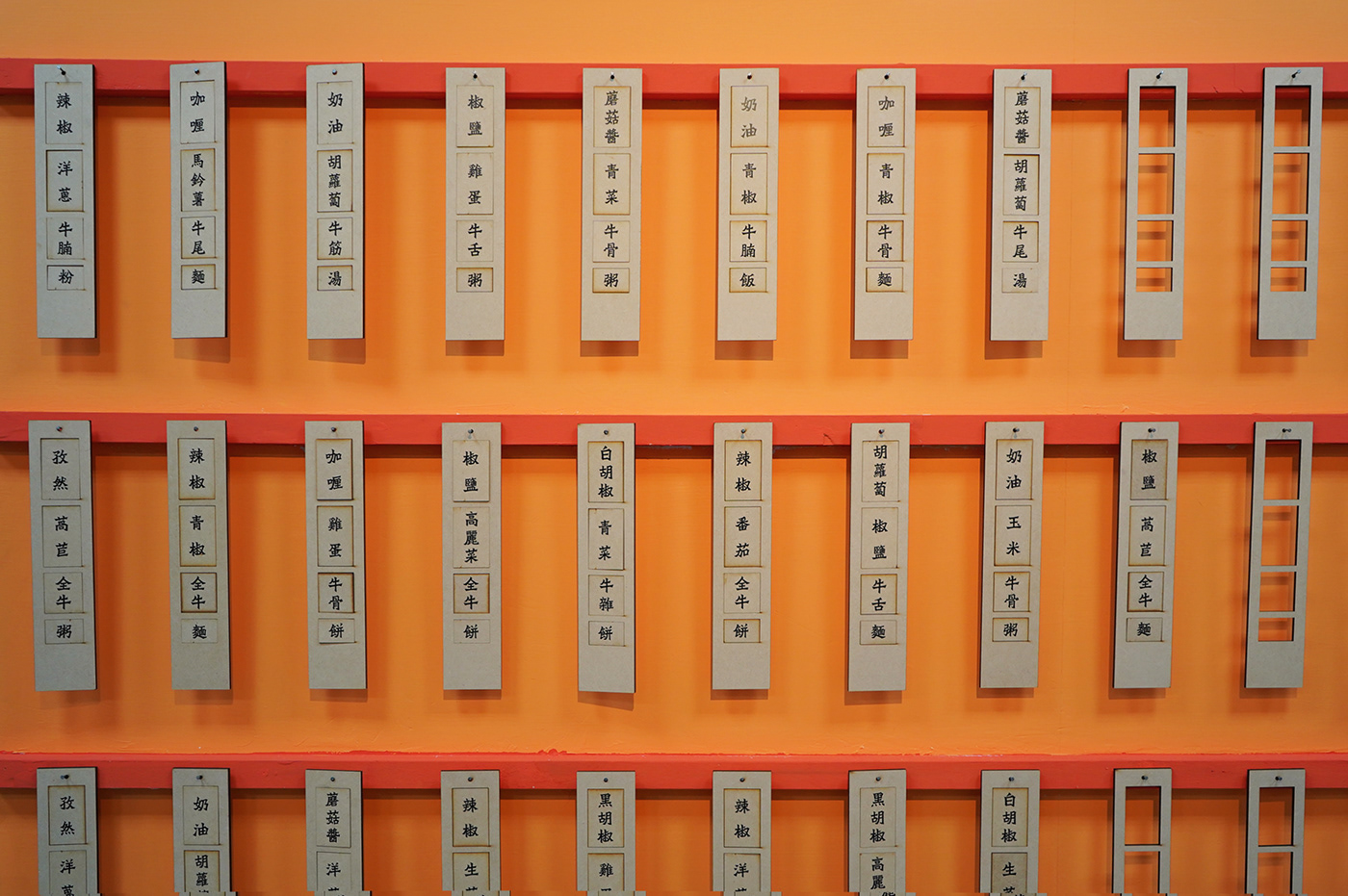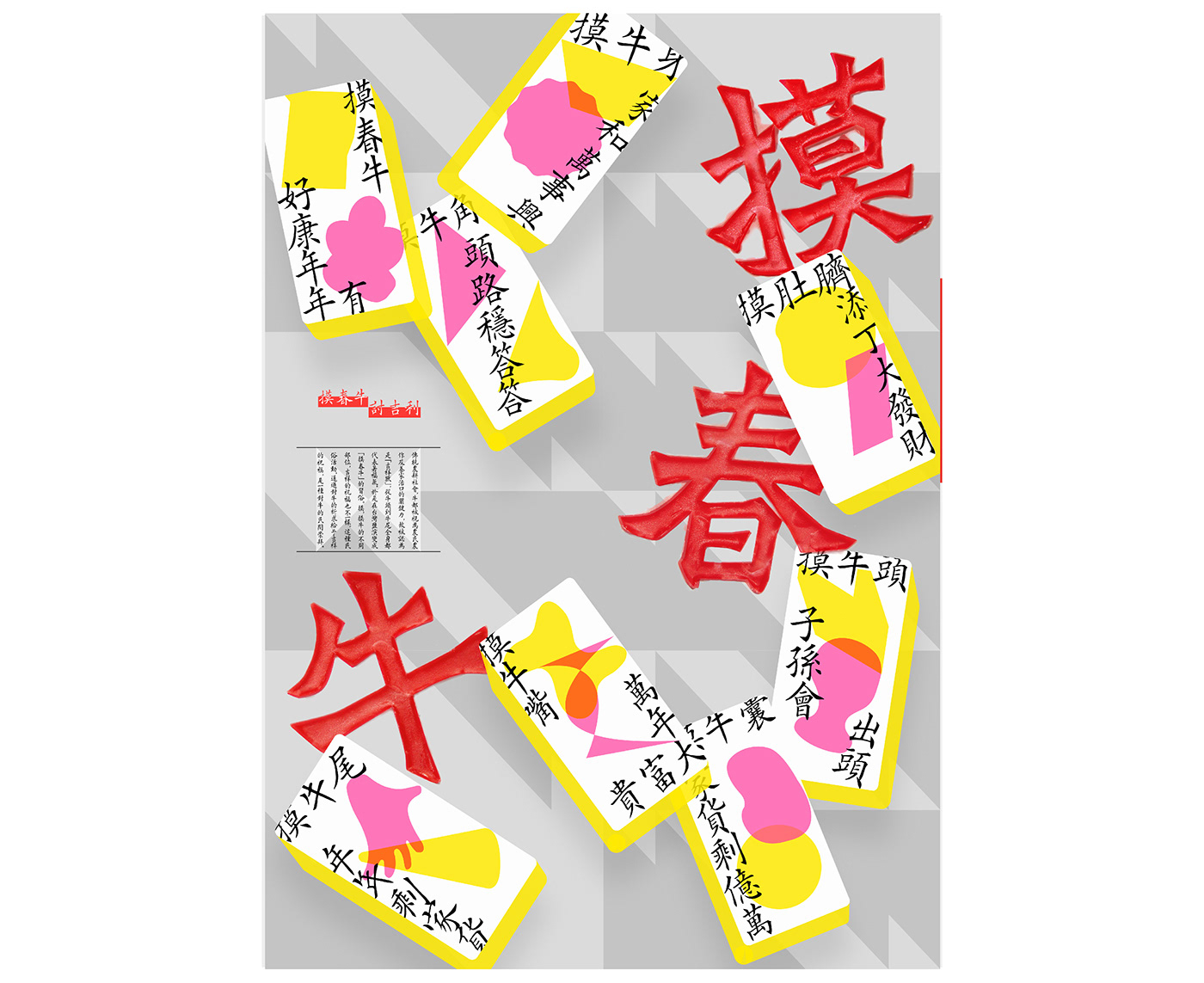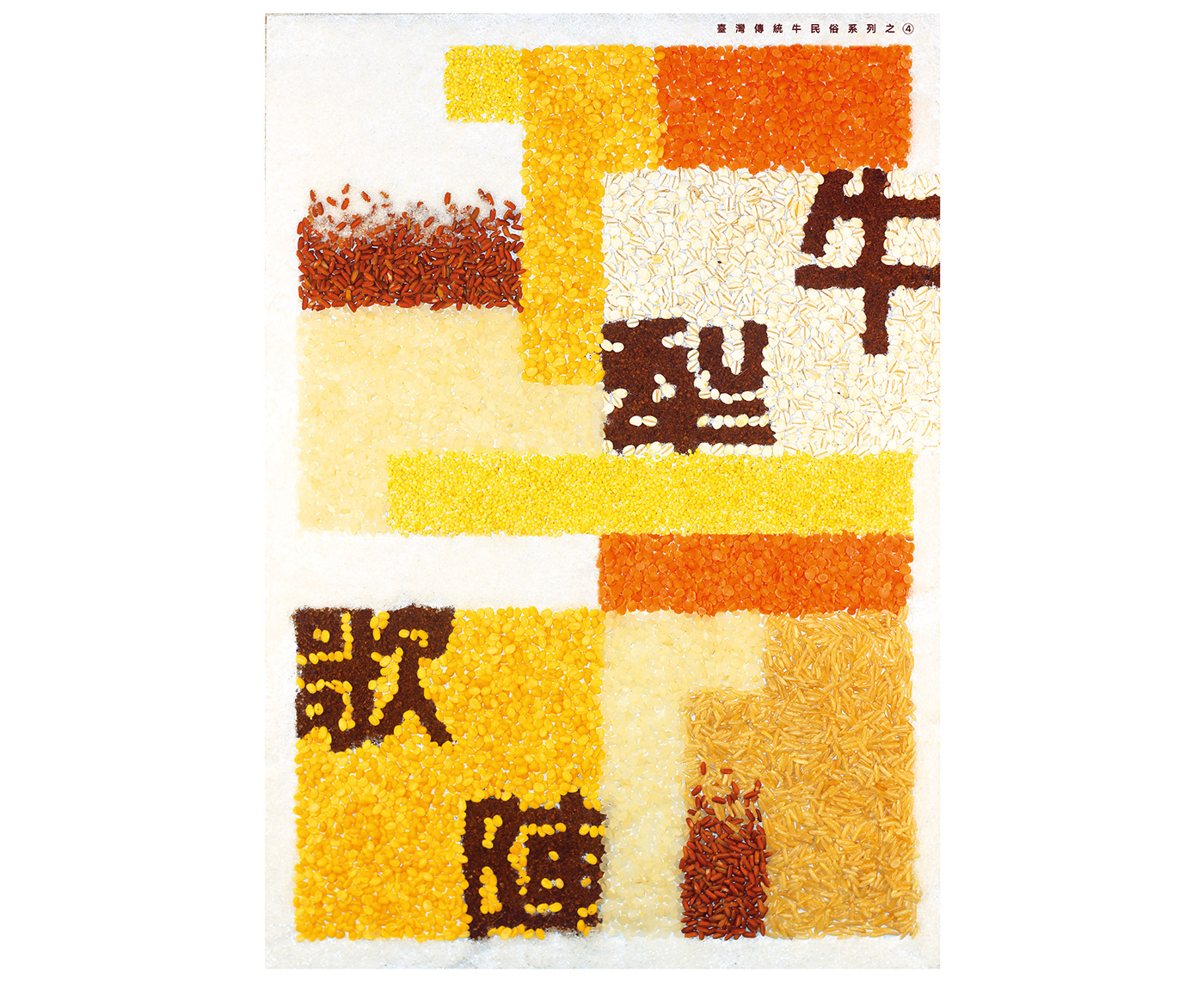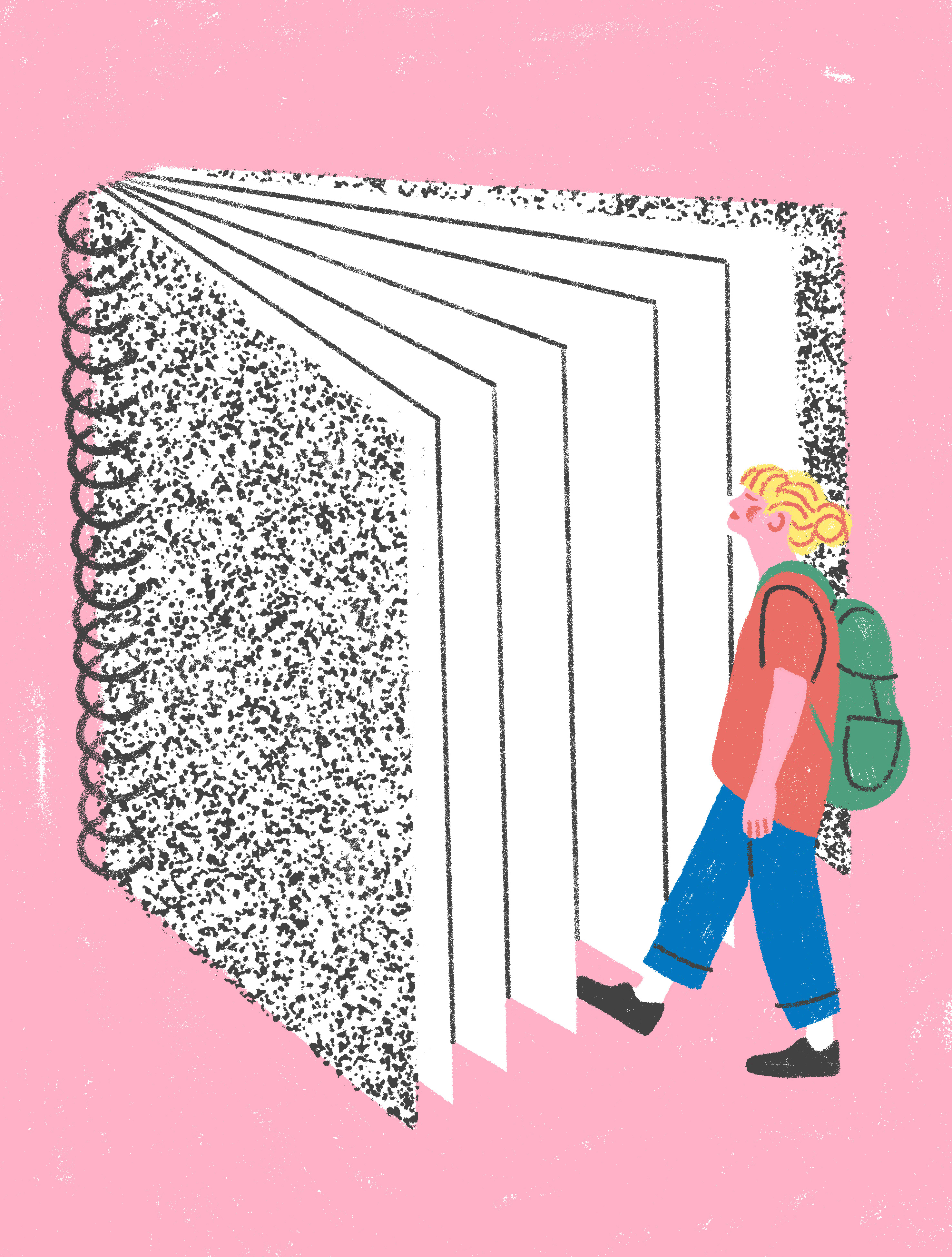
犇 - 牛的岛屿记事 | 李佳灵硕士毕业创作展
BEN - AN ISLAND CHRONICLE OF CATTLE
LI JIA LING DESIGN GRADUATION SHOW
日常生活元素的提炼与再创作可能性?
以牛肉面为代表的牛肉饮食不仅凸显了台湾口味,也根植于台湾饮食文化之中,而饮食中的食材又与这块土地有着紧密的相关性。广义的来看,饮食的喜好也反映出该地人民的某些特质。你知道吗?追溯到50多年前的台湾,许多当地人是不吃牛肉的,更不用说牛肉面了。因为台湾民间长期普遍存在着深厚的「耕牛敬畏」、「食肉禁忌」心里。而这又要从耕牛与台湾农业社会之间的关系说起:耕牛对于台湾是一种外来产物,伴随着开垦台湾而外引进的农业工具,从南走到北经历了台湾从荒芜开垦至沃土的耕耘史,可视为台湾开发史的一种指标。台湾农民常自称「台湾牛」,意指任劳任怨的特性。台湾谚语中也常利用「牛」来打比方,例如「无挂牛嘴笼」指小孩贪嘴。甚至演变出很多和牛有关的民俗来。
我归纳出三种日常存在与牛的不同关系:分别为「日常关系」、「共生关系」和「崇敬关系」。展览分为三个板块,从三个视角去诠释在台湾社会中人与牛的三种关系,所以把展览的名字命名为「犇」。同时每一个部分又以一种表现形式来表达。之所以选定牛意象的原因也是在日常的生活经验中发现该元素有被提炼的文化价值属性,及能运用设计手法表达的可能性,实现和观众产生共鸣互动。最终将牛这一文化符号通过策展设计的手法构建成一个完整展览呈现给大家。
The possibility of refining and recreating elements of daily life?
The beef diet represented by beef noodles not only highlights Taiwanese tastes, but also is rooted in Taiwanese food culture, and the ingredients in the diet are closely related to this land. Broadly speaking, food preferences also reflect certain characteristics of the people in the region. Do you know? Back in Taiwan more than 50 years ago, many locals didn't eat beef, let alone beef noodles. For a long time, people in Taiwan have been deeply concerned about the "reverence for oxen" and the "taboo of eating meat". This is based on the relationship between farming cattle and Taiwan's agricultural society: farming cattle are a kind of foreign product for Taiwan. With the introduction of agricultural tools from Taiwan to the outside world, they have experienced the history of farming from the wilderness to the fertile soil in Taiwan from the south to the north, which can be regarded as an indicator of the development history of Taiwan. Taiwanese farmers often refer to themselves as "Taiwan cattle", referring to their hard-working nature. Taiwanese proverbs often use the term "ox" as an analogy. For example, "a cage without a hanging ox's mouth" means a greedy child. And it even evolves many customs related to cattle.Chinese mainlanders's perspective will form a distinct point of view from that of the Taiwanese? This idea of different perspectives also runs through the design of the whole exhibition.
I generalize three different kinds of relationships between everyday beings and cows: "everyday," "symbiosis," and "reverence relationships." The exhibition is divided into three sections, explaining three kinds of relations between people and cattle in Taiwan society from three perspectives, so the exhibition is named "Ben". At the same time, each part is expressed in a pattern of manifestation. The reason why we choose cow image is that we find in our daily life experience that this element has the attribute of cultural value extracted, and the possibility of using design techniques to express, so as to achieve resonance and interaction with the audience. Finally, the cultural symbol of cow is constructed into a complete exhibition to present to you through the method of curation and design.





展览现场照片
Exhibition site photos
日常关系 | Daily relationship
最为显著的就是饮食关系,牛是台湾日常生活中最重要的食材之一,台湾人很喜欢吃牛肉,在夜市逛一逛就能发现各种关于牛的小吃。日常饮食文化里也充斥著各种牛肉料理。牛与人的关系日常同时又必不可缺。以饮食文化作为切入口,作品想表达的主题是「选择」,因为牛在台湾饮食文化中的丰富性,且与台湾人日常生活密切的连接性。作品的表现形式以字体为主,因为牛之余我们的生活是一种日常关系,字体同样也是很日常的素材。所以笔者想到用日常的素材去诠释一个很日常的主体,同时字体背后所代表的巨大数字量以及内涵,也可以契合丰富性的主体。同时字体是一个载体,我们要去呈现什么我们想要表达的内容,这其中也就是选择。
The most prominent one is the dietary relationship. The beef is one of the most important ingredients in Taiwan’s daily life. Taiwanese like eating beef very much. As long as you walk at the night fair, you can find a variety of snacks about beef. The daily food culture is also full of various beef dishes. The relationship between beef and people is indispensable at the same time. Taking food culture as the point of penetration, the theme that the work wants to express is “choice”, because beef has richness in Taiwan’s food culture and has close connection with Taiwanese daily life. The form of the work is mainly font, because the life with the beef is a daily relationship, and the font is also a daily material. Thus, usually while an author thinks of using daily materials to interpret a very daily subject, there is huge amount of digital and connotation behind the font which agrees with the rich subject. At the same time, the font is a carrier, what we want to present and what we want to express are just the choice.












在日常关系中,以字体作为表现形式。在这板块中设计师结合牛的造型与感觉特别设计了一款字体,适合用在餐饮行业的招牌与标志上使用。
In a Daily relationship, the font is used as the representation. In this section, the designer specially designed a font combining the shape and feeling of cow, which is suitable for use on the signboards and signs of the catering industry.
共生关系 | Symbiotic relationship
可以说以牛肉面为代表的牛肉饮食不仅凸显了台湾口味,也根植於台湾饮食文化之中。一个大众饮食习惯的养成,绝不是一两天的事情,而是一个长久的过程。饮食中的食材又与这块土地有著紧密的相关性,广义的来看,饮食的喜好也反映出该地人民的某些特质。然而追溯到50多年前的台湾,许多当地人是不吃牛肉的,更不用说牛肉面了。台湾民间长期普遍存在著深厚的「耕牛敬畏」、「食肉禁忌」心里。这又要从耕牛与台湾农业社会之间的关系说起。可知耕牛对于台湾是一种外来产物,伴随着开垦台湾而外引进的农业工具,同时也可以用作交通运输与生产蔗糖之用的生产工具。牛只的出现於台湾社会的各个角落,伴随着人类从南走到北、由西走到东开,经历了台湾从荒芜开垦至沃土的耕耘史,可视为台湾开发史的一种指标。
这一部分的主题「聆听」:以客观中立的视角去讲述一个历史文化演变的过程。牛不是人类活动的附庸品,人与牛分別都是共同生长在同一环境下,彼此相对独立的生物体。这部分的创作以资讯图表可视化的方式去解释牛从哪里来,台湾人从不吃牛到吃牛过程的历史演变。把这一段不太熟悉的历史过程展现给观者看。
It can be said that the beef diet that is represented by beef noodles not only highlights Taiwanese taste, but is also rooted in Taiwanese food culture. The development of a popular eating habit is not a matter of that can be achieved within a day or two, but a long-term process. The ingredients in the diet are closely related to the land. In a broad sense, the preference of the diet also reflects certain characteristics of the people in the area. However, dating back to in Taiwan in more than 50 years ago, many local people there did not eat beef, let alone beef noodles. For a long time, the Taiwanese have the idea of “reverence toward farm cattle” and “carnivorous taboos” deep in their mind. This originates from the relationship between farming cattle and Taiwan’s agricultural society. It is known that farming cattle is a foreign product for Taiwan, which is accompanied by agricultural tools introduced outside of Taiwan and which can also be used as a production tool for transportation and producing sugar. Cattle only appeared in all corners of Taiwanese society at that time. With human beings’ from the south to the north, from the west to the east, and experiencing the history of Taiwan’s cultivation from barren ground to fertile soil, it can be regarded as an indicator of Taiwan’s development history.
The theme of this part is “listening”: a process of telling the evolution of a historical culture from an objective and neutral perspective. A cattle is not an appendage of human activities. Humans and cattle are both the organisms that grow together in the same environment and are relatively independent of each other. The creation of this part uses information visualization to explain where the cattle comes from and the historical evolution of Taiwanese people who change from never eating beef to eating beef. Show this unfamiliar historical process to the viewer.

视觉设计:李佳灵 | 脚本设计:李佳灵 | 动态设计:梁超逸





同时在展示形式上也做了设计,将插图埋在五十斤稻谷下,观者在接触稻谷的同时发现藏在稻谷下的插图,从而探索其他的信息。这一部分讲述的是关于牛的历史,而牛在古代是重要的农耕工具农耕最终产物就是稻谷这类的粮食。 观者在拨开稻谷寻找插图的过程很像在挖掘历史。
At the same time, the design was also made on the display form, and the illustrations were buried under 50 catties of rice. When the audience touched with the rice, they found the illustrations hidden under the rice, so as to explore other information. It's about the history of the cow, which was an important agricultural tool in ancient times. And the end product of farming was grains like rice. The viewer is digging through the rice for illustrations, much like digging through history.
崇敬关系 | Respect relationship
我们对食用牛肉习以为常的同时,这个世界上也存在不吃牛肉的人。这里面存在一部分人是出于对牛的情感。在台湾社会中,农业依旧是一个很具有代表性的产业。牛与农业之间有著密不可分的关系,从农耕文明一路走来的人类文明,牛扮演的不仅仅是伙伴或工具,更是造物对于人类的餽赠。对于牛的情感,可以说也是对台湾土地的情感。
文化经过历史的演变,如今以民俗的形式传承至今。时至今日,依然存在著许多和牛有关的民俗,它们以诸如曲艺、传说、习俗、信仰等形式存在于民间中,但是随着在台湾社会结构中农业比重的逐步下降,这些民俗逐渐式微。所以在这一部分中,我们以海报的形式,试图去了解这些和牛有关的民俗,以达到传承的目的。
While we are used to eating beef, there are people in the world who do not eat beef. The reason for the existence of these people is their emotions about the cattle. In Taiwan society, agriculture is still a very representative industry. There is an inseparable relationship between cattle and agriculture. From the human civilization that comes from farming civilization, cattle not only plays the role of partners or tools, but also are the gifts for human beings. For the affection to cattle, it can be said that it is also the affection of Taiwan’s land.
The evolution of culture through history has now been passed down in the form of folklore. Up to now, there are still many folklore related to cattle, which exist in the folks in the form of songs, legends, customs, beliefs, etc.. But with the gradual decline of the proportion of agriculture in Taiwan’s social structure, these folk customs have shown a gradual decline. So in this part, we try to understand the folklore related to the cattle in the form of a poster so as to achieve the purpose of inheritance.





犇 - 牛的岛屿记事 | 李佳灵硕士毕业创作展
BEN - AN ISLAND CHRONICLE OF CATTLE
LI JIA LING DESIGN GRADUATION SHOW
Creative director/ 李根在 Ken-tsai Lee
Graphic Design/ 李佳灵 Jia-ling Lee
Exhibition Design/ 李佳灵 Jia-ling Lee
Motion Design/梁超逸 Chao-yi Liang
Curation Execution/ 李佳灵 Jia-ling Lee、许智伟 Dennis Hsu 、周璐 Lu Zhou 、
黄晗 Han Huang 、廖彥熹 Yan-xi Liao、吴文娟 Wen-juan Wu
Photographer/ 许智伟 Dennis Hsu
感谢收看
Thanks for watching








